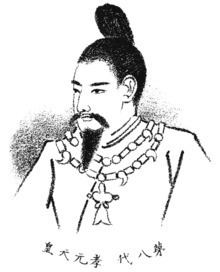Died 158 BC Children Emperor Kaika | Successor Kaika Parents Emperor Kōrei | |
 | ||
Reign 214 BC – 158 BC (traditional) Burial Tsurugi no ike no shima no e no misasagi (Nara) Similar | ||
Emperor Kōgen (孝元天皇, Kōgen-tennō), also known as Ooyamatonekohikokunikuru no Mikoto, was the eighth emperor of Japan, according to the traditional order of succession.
Contents
No firm dates can be assigned to this emperor's life or reign, but he is conventionally considered to have reigned from 214 BC to 158 BC.
Legendary narrative
Modern scholars have come to question the existence of at least the first nine emperors; Kōgen's descendant, Emperor Sujin is the first that many agree might have actually existed. The name Kōgen-tennō was assigned to him posthumously by later generations.
Kōgen is regarded by historians as a "legendary emperor". There is insufficient material available for further verification and study. The reign of Emperor Kinmei (c. 509 – 571 AD), the 29th emperor, is the first for which contemporary historiography is able to assign verifiable dates; However, the conventionally accepted names and dates of the early emperors were not to be confirmed as "traditional" until the reign of Emperor Kanmu (737–806), the 50th sovereign of the Yamato dynasty.
In the Kojiki and Nihonshoki only his name and genealogy were recorded. The Japanese have traditionally accepted this sovereign's historical existence, and an Imperial misasagi or tomb for Kōgen is currently maintained; however, no extant contemporary records have been discovered that confirm a view that this historical figure actually reigned. He is considered to have been the seventh of eight emperors without specific legends associated with them, also known as the "eight undocumented monarchs" (欠史八代,, Kesshi-hachidai).
Jien records that Kōgen was the eldest son of Emperor Kōrei, and that he ruled from the palace of Sakaihara-no-miya at Karu in what would come to be known as Yamato Province. The Abe clan are said to have descended from a son of Emperor Kōgen. It is believed that he was his father's successor, and that he was himself succeeded by his son.
Kōgen is a posthumous name. It is undisputed that this identification is Chinese in form and Buddhist in implication, which suggests that the name must have been regularized centuries after the lifetime ascribed to Kōgen, possibly during the time in which legends about the origins of the Yamato dynasty were compiled as the chronicles known today as the Kojiki.
The actual site of Kōgen's grave is not known. This emperor is traditionally venerated at a memorial Shinto shrine (misasagi) in Nara.
The Imperial Household Agency designates this location as Kōgen's mausoleum. It is formally named Tsurugi no ike no shima no e no misasagi.
Consorts and Children
Empress: Utsusikome (欝色謎命), younger sister of Utsusikoo (欝色雄命)
Ikagashikome (伊香色謎命), daughter of Oohesoki (大綜麻杵)
Haniyasuhime (埴安媛), daughter of Kawachi no Aotamakake (河内青玉繋)
